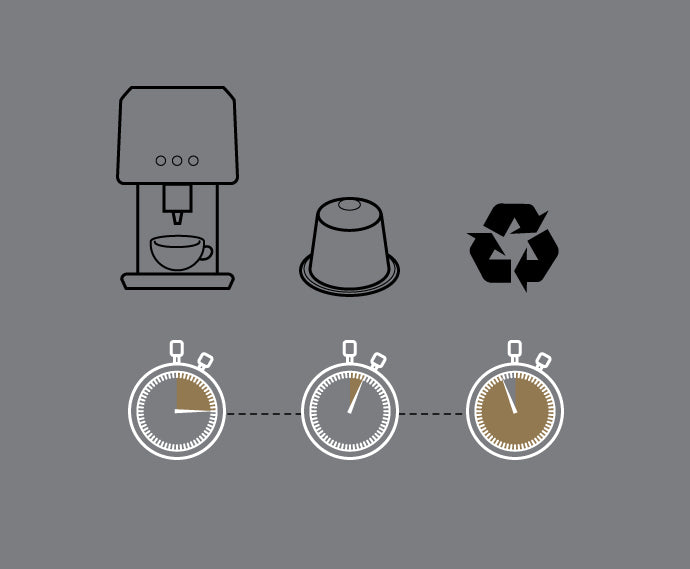ENJOY 15% OFF A NEW SUBSCRIPTION

The History of Encapsulated Coffee
The history of coffee has always been a remarkable story. The bean has travelled across the world for centuries, smuggled out from protective countries, stolen from royalty, and changed the entire economies of nations. It’s fascinating how one small bean from wild trees in Yemen and Ethiopia has become the 2nd largest trading commodity in the world.
While you might be well aware of the different coffee origins, the history of encapsulated coffee is less well-known.
Have you ever wondered who invented the popular Nespresso capsules, or the K-Cups? Are encapsulated coffee pods safe for the environment? Is now the time we swap to compostable coffee pods? Well, we break it down for you here.
The History Behind Coffee Capsules
The invention of the coffee capsule has changed the coffee making industry and revolutionalised how people drink coffee today.
Over the past few years, coffee capsules have registered increased popularity to become one of the few distinctive beverages of choice. While traditional ways of brewing coffee remain, the Nespresso system has beyond doubt become the easiest and most efficient way to fix our morning coffee.
In fact, fixing a cup of espresso coffee takes me about 25 seconds, giving a delicate, concentrated shot of coffee with a thick, delicious crema.
The concept behind Nespresso was hatched and patented by Mr Eric Favre in 1976. It was a simple but revolutionary concept that aimed to enable anyone in the world to prepare a perfect cup of coffee that tastes just like that of skilled baristas. Through the Nespresso concept, millions of people have changed the way they make their morning fix.
Eric Favre was an employee of Nestle when he got agitated by how long it took the coffee making machines to prepare his morning cup of coffee. He realised that by adding more pressure into the process, the waiting time shortened and the resulting coffee was more abundant in crema. From there, the concept of encapsulated coffee came to life.
The Arrival of K-Cup
After seeing the success of Nespresso single-serves in the European market, Keurig, a coffee machine manufacturing company based in the United States, embarked on designing today’s famous K-Cup pods. These single-serve K-cups were introduced in the US market in 1998. The main focus was in the office niche, but after the surge in popularity, the company launched its first home-use brewers in 2004.
In 2011 and 2012, Nespresso and Keurig’s main patent expired, respectively. This allowed competitors to enter the coffee pod market with compatible variations of the beloved Nespresso and K-Cup pods.
Admission of Guilt about Environmental Damage
“No matter what they say about recycling, those things will never be recyclable. The plastic is a specialised plastic containing four different layers,” said John Sylvan, creator of the K-Cup.
Such admissions of the environmental impact of coffee pods caused consumers to realise the true impact of their coffee habits and fuelled anger among various groups of environmentalists. In recent years, concerns have increased over the extent of damage caused by the disposal of K-Cup and Nespresso pods in the environment.
It’s estimated that between 1998 and 2012, coffee pods made up about 1% of the total waste in the landfill of Germany and Switzerland. The main contributing factor is that the standard recycling programs do not accept single-serve coffee pods. The capsules are too small to pass through the sieve during the sorting process. Furthermore, the various materials used to construct a single pod must be carefully removed at specialised facilities hence the difficulty for kerbside recycling.
The Current State of Sustainability
A brief history of coffee tells us that coffee production and consumption was a once sustainable process that synched in harmony with the environment. Coffee consumption practices have gone from good to bad, and now ugly. However, all hope is not lost.
There have been remarkable advancements and inventions as coffee companies race to develop biodegradable and compostable capsule packaging.
Compostable materials are largely acknowledged as the most sustainable but compostable capsules are categorised into two: industrial and home compostable. Industrial compostable pods require exposure to very specific conditions, elevated temperatures (55-70C) and high humidity, to breakdown. Home compostable pods are more forgiving and will break down at much lower temperatures and under more natural conditions than industrially compostable materials.
Take Responsibility
The power of choice is in our hands and it is our duty to protect our planet by considering the impacts of our choices. It’s a matter of personal and collective responsibility for all coffee lovers to practice sustainable coffee drinking habits.
